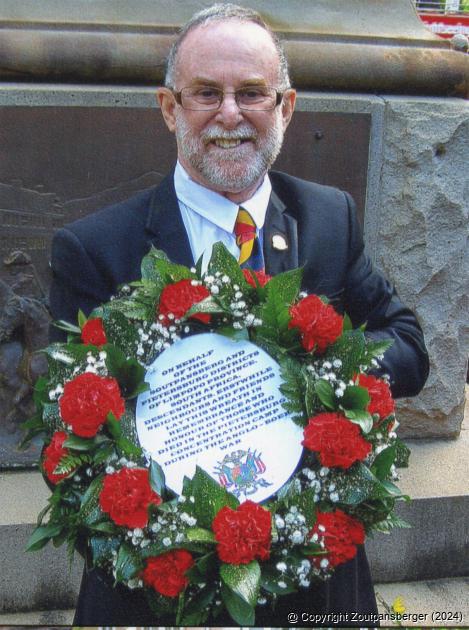

ADVERTISEMENT:

John Sweetman with the wreath that was laid on behalf of the Lalapanzi Museum and Heritage Foundation, together with the Zoutpansberg Skirmishes Route, to remember the casualties in the Pietersburg concentration camp. The inscription on the wreath reads: “On behalf of the Soutpansberg and Pietersburg Districts of Limpopo Province, South Africa, Descendants, Erstwhile Neighbours and Friends, lay this wreath in remembrance and honour of those who died in the Pietersburg Concentration Camp during the Anglo-Boer War".
Australia remembers victims of Boer War concentration camps
Date: 16 July 2016 By: Anton van Zyl
The annual Anglo-Boer War Commemoration and Reconciliation Service held in Perth, Australia, had a distinctively Limpopo flavour last month. For the first time in 114 years, a wreath was laid to also commemorate the women, men and children who had died in the Pietersburg concentration camp.
According to local historian Mr Charles Leach, he heard from a friend that, during the service on 5 June, the Emily Hobhouse wreath would be laid in honour and remembrance of the deaths in South African concentration camps. He immediately thought that it would be fitting for a wreath to be laid during this ceremony to specifically honour the local residents who had made the ultimate sacrifice during this war.
“The Pietersburg camp was the closest to Louis Trichardt and served, among other regions, the entire northern section of what is today known as Limpopo Province. The camp was opened by the British forces on 11 May 1902 and at times held more than 4 000 inmates,” he explained.
After the ‘raid’ on the camp by General Beyers on 23 January 1902, with the objective to ‘release’ the approximate 130 Boer commando members who had surrendered their weapons and joined the camp inmates, the British temporarily relocated the inmates – mostly women, children and elderly men – to Colenso and Pinetown. By the end of the war and with the gradual closure of the camp, 657 deaths had occurred, comprising 88 women, 523 children and 46 men.
“One of the mandates of the Bushveldt Carbineers and the British Army Intelligence Department under command of Capt ‘Bulala’ Taylor was the ‘rounding up’ of all civilians who were still at large and on isolated farms in the region and transporting them to the Pietersburg Camp,” said Charles. “It was thus fitting that the Lalapanzi Museum and Heritage Foundation, together with the Zoutpansberg Skirmishes Route, arranged for a wreath to be laid at the service in Perth in remembrance and honour of those who had perished in the Pietersburg camp.”
According to Charles, he contacted the South African Military Veterans Organisation of Australasia (SAMVOA) and they were extremely enthusiastic about the idea. “They even kindly offered to pay for our wreath,” he said.
The service in Perth was quite a memorable event and the programme even included a rendition of the Afrikaans song, Sarie Marais. This was performed by Lourens van der Linde. The Boer War Day Choir performed the popular Boer War period song, Goodbye Dolly Gray. “The weather was beautiful and the scene of the service, a mass of colour from both the gardens and the many wreaths,” said John Sweetman, a historian who represented the Boer War Memorial Society of Western Australia.
John Sweetman and Garth Pienaar from SAMVOA laid the wreath on behalf of the Soutpansberg and Pietersburg districts of Limpopo Province.
“It is indeed heartwarming and a great honour to be associated with men and women of the calibre of John and Garth and so very many others in Australia who go to great lengths to keep their rich military heritage and history vibrantly alive,” said Charles Leach.
Viewed: 1834
|
|
Tweet |

-

Former Triegie’s acting career taking off
12 April 2024 By Karla van Zyl -

'Temporary fix is safe, but do not touch cables,' says municipality
12 April 2024 By Andries van Zyl -

Another R2 million pumped into broken pool
12 April 2024 By Andries van Zyl -

Louis Trichardt se rugbymanne wys reeds vroeg in die seisoen tande
12 April 2024 By Andries van Zyl -

Havinga waarsku teen koue en droë winter
11 April 2024 By Andries van Zyl

Anton van Zyl
Anton van Zyl has been with the Zoutpansberger and Limpopo Mirror since 1990. He graduated from the Rand Afrikaans University (now University of Johannesburg) and obtained a BA Communications degree. He is a founder member of the Association of Independent Publishers.

More photos...

A wreath is being laid by a representative dressed in period uniform to commemorate the thousands of horses, mules and donkeys that also served in the South African war. In the foreground is the “Bothaville” Krupps.

The SA War Memorial in Perth can be seen in the background, with the wreaths lying at its base. In the foreground is the “Bothaville” Krupps, one of the canons used during the Anglo Boer War. Boer general Christiaan de Wet had to abandon four of these Krupp field guns during the Battle of Bothaville in November 1900.

ADVERTISEMENT


-

Park development leaves residents puzzled
22 March 2024 By Andries van Zyl -

Local para-athletes shine at SA Champs
05 April 2024 -

Epic finish for local cycling duo
29 March 2024 By Andries van Zyl -

What next Vhembe!
22 March 2024 By Andries van Zyl -

Debt-collection company apologises for rude letter
29 March 2024 By Anton van Zyl

ADVERTISEMENT:


ADVERTISEMENT


